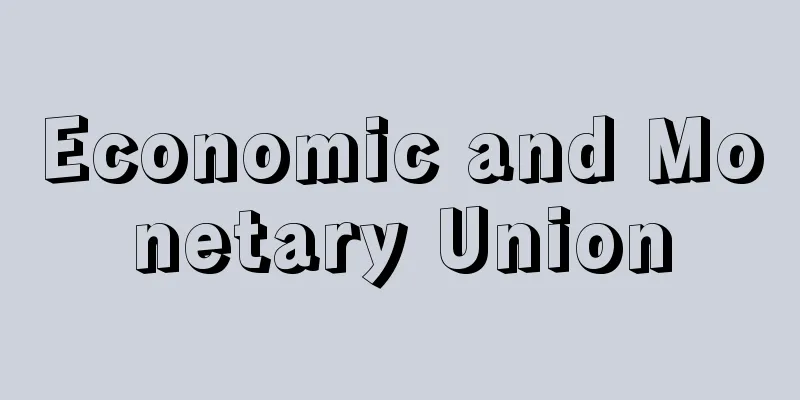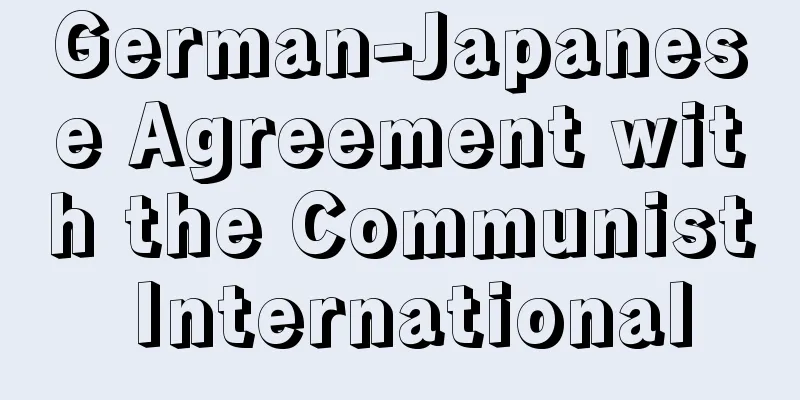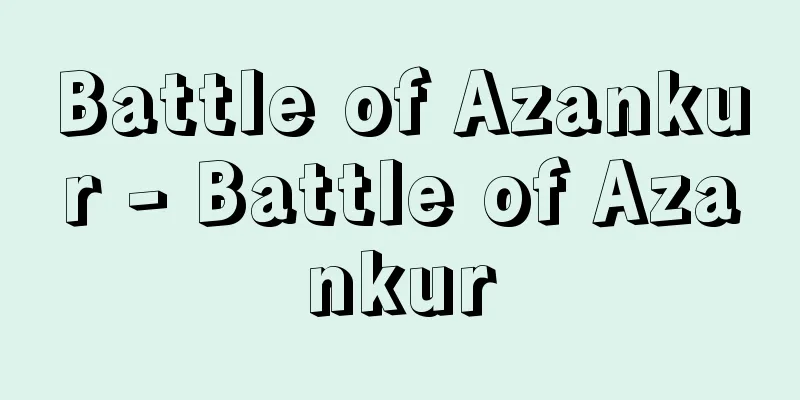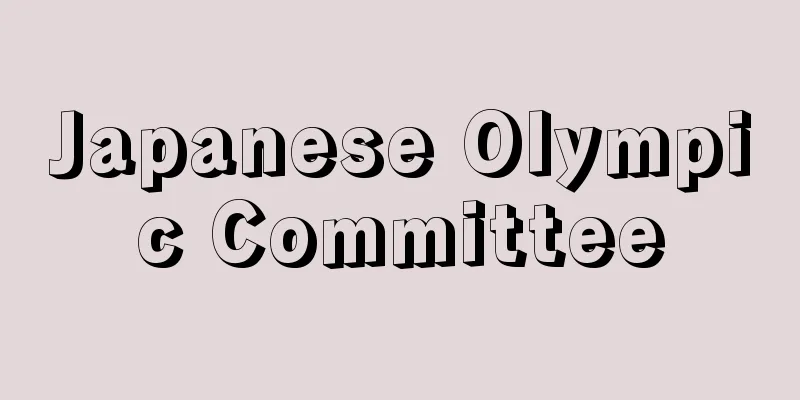Economic and Monetary Union

|
The core of the European Union (EU), an alliance that aims to complete economic and monetary unification. Abbreviated as EMU. It consists of the Economic Union, which has a single market at its core, and the Monetary Union, which is made up of a single currency, free capital movement, and an independent central bank that operates a single monetary policy. The basic structure of the Economic and Monetary Union was already outlined in the Werner Commission report issued in 1970, but after further consideration and reporting by the Delors Commission (submitted in April 1989), the basic structure, schedule, and conditions for participation (convergence criteria) were finalized in the Maastricht Treaty (which came into force in November 1993). [Iku Hoshino November 19, 2018] Until the alliance is realizedThe first stage of the Economic and Monetary Union started in July 1990, prior to the Maastricht Treaty, and included the liberalization of capital movements and the strengthening of economic policy coordination to stabilize the European Monetary System (EMS). In the second stage, which began in January 1994, the European Monetary Institute (EMI) was established, which was succeeded by the European Central Bank (ECB) in June 1998. The name of the single currency was decided to be the Euro in December 1995, and the Stability and Growth Pact, which stipulated fiscal discipline for euro-member countries, was also signed in June 1997. After the euro-member countries were decided to be 11 of the 15 EU member countries (at the time), excluding the UK, Greece, Sweden, and Denmark, in May 1998, the final stage began in January 1999, and the introduction of euro cash was completed in early 2002. The Eurozone is a monetary union with 19 member countries as of the end of 2017. With the exception of the UK and Denmark, which have the right to be exempt from membership, EU member states are obligated to join the monetary union in principle. [Iku Hoshino November 19, 2018] Future challengesAlthough Economic and Monetary Union is formally complete, the euro crisis has revealed various problems and flaws, and the EU is aiming to overcome these challenges by building a "genuine Economic and Monetary Union." Regarding monetary union, as the euro crisis revealed the fragmentation of the eurozone financial system and the dysfunction of banks, it is essential that there is an integrated and well-functioning financial system, and so the EU aims to realise a Financial Union consisting of banking union and capital markets union by 2019. Regarding economic union, as the euro crisis revealed problems with economic convergence (correcting disparities in economic and industrial structure, levelling out competitiveness, synchronising business cycles, etc.), incomplete structural reform, and a lack of fiscal discipline, the EU aims to realise a more integrated Economic and Fiscal Union through the coordination of economic policies, strengthening fiscal discipline and support for reform from the EU budget. In addition, the euro crisis has led to harsh criticism of the inefficient governance of EU institutions, harsh austerity policies, and the forced painful structural adjustment, and as a result, efforts are being made to reform the organization and governance of EU institutions and to promote democratic accountability. Regarding the former, organizational and governance reform, the creation of the European Monetary Fund (EMF), the integration of the Fiscal Compact, which is a key part of the intergovernmental treaty "Treaty on Stability, Coordination and Governance," into EU law, the creation of a European Minister of Economy and Finance who will serve as the permanent chairman of the Eurogroup, a gathering of finance ministers in the eurozone, and also as a Vice-President of the European Commission, and the consideration of new fiscal measures to stabilize the eurozone, are being promoted. Regarding the latter, democratic accountability, the issues being addressed include dialogue between the European Parliament, the national parliaments of the EU countries, and the European Commission, as well as strengthening social dialogue between labor and management. Through these reforms, the EU aims to complete a "true Economic and Monetary Union" by 2025. [Iku Hoshino November 19, 2018] Economic and Monetary Union and its relations with other unionsWhen the idea of monetary union emerged at the end of the 1960s based on the progress of European economic integration centered on the customs union and the common agricultural policy, it was said to consist of both an economic union and a monetary union (Economic and Monetary Union). After setbacks in the 1970s, when the idea of monetary union emerged again at the end of the 1980s, it was said that in order for the economic and monetary union to ultimately function well, it was essential to establish a fiscal union that would carry out large-scale fiscal transfers at the EU level in parallel with the establishment of the union, and a political union that would politically justify and make possible the fiscal transfers. However, even after the economic and monetary union reached its final stage with the introduction of the euro, there has been no clear progress in fiscal union and political union. On the other hand, since the euro crisis revealed the vulnerability of the euro area's banking system and the inadequacy of the role of capital markets, the creation of banking union has been followed by the creation of capital markets union. The "true economic and monetary union" that the EU ultimately aims to achieve can be seen as an economic and monetary union supplemented by a financial union (banking union + capital markets union) and a fiscal union, further complemented by a political union. [Iku Hoshino November 19, 2018] "Prospects for EC Monetary Integration" edited by Aizawa Yukiyoshi (1992, Dobunkan Publishing)" ▽ "EMS: European Monetary System - Focus of European Monetary Integration" edited by Tanaka Motoka (1996, Yuhikaku)" ▽ "Immortal Europe - Past, Present and Future" by Theo Sommer, translated by Kato Mikio (2000, Iwanami Shoten)" ▽ "The Euro and the EU Financial System" edited by Iwata Kenji, H.E. Schaller et al. (2003, Nihon Keizai Hyoronsha)" ▽ "The Euro and the International Monetary System" edited by Tanaka Motoka and Fujita Seiichi (2003, Sotensha Publishing) [References] | | | | | | | | | | |Source: Shogakukan Encyclopedia Nipponica About Encyclopedia Nipponica Information | Legend |
|
ヨーロッパ連合(EU)の中核で、経済・通貨統合の完成を目ざす同盟。略称EMU(エミュー)。単一市場を中核とする経済同盟Economic Unionと、単一通貨と自由な資本移動、単一金融政策を運営する独立した中央銀行で構成される通貨同盟Monetary Unionからなる。経済通貨同盟の基本的な構図は、1970年に出されたウェルナー委員会報告ですでに示されていたが、ドロール委員会での検討と報告(1989年4月提出)を経て、マーストリヒト条約(1993年11月発効)で、その基本的な構図やスケジュール、参加条件(収斂(しゅうれん)基準)が確定された。 [星野 郁 2018年11月19日] 同盟の実現まで経済通貨同盟の第一段階は、マーストリヒト条約の締結に先だち、1990年7月よりスタートし、資本移動の自由化や、ヨーロッパ通貨制度(EMS)安定化のための経済政策の協調強化などが進められた。1994年1月より始まる第二段階では、ヨーロッパ通貨機構(EMI:European Monetary Institute)が設立され、1998年6月よりヨーロッパ中央銀行(ECB)に引き継がれた。1995年12月には単一通貨の名称がユーロEuroと決定され、1997年6月には、ユーロ参加国の財政規律を定めた安定成長協定Stability and Growth Pactも締結された。1998年5月にユーロ参加国がEU加盟15か国(当時)中イギリス、ギリシア、スウェーデン、デンマークを除く11か国と決定された後、1999年1月より最終段階に移行し、2002年初めにユーロ現金の導入が完了した。通貨同盟であるユーロ圏には、2017年末時点で19か国が参加している。参加免除の権利を有するイギリス、デンマークを除き、EU加盟国は原則通貨同盟に参加する義務を負っている。 [星野 郁 2018年11月19日] 今後の課題経済通貨同盟は、形のうえでは完成しているものの、ユーロ危機によってさまざまな問題点や欠陥が明らかになったことから、EUは「真の経済通貨同盟(a genuine Economic and Monetary Union)」の構築により、それらの課題の克服を目ざしている。 通貨同盟に関しては、ユーロ危機によってユーロ圏の金融システムの分断や銀行の機能不全が明らかになったことから、統合されうまく機能する金融システムが不可欠として、2019年までに銀行同盟と資本市場同盟からなる金融同盟Financial Unionの実現を目ざしている。経済同盟に関しては、ユーロ危機によって経済収斂(経済・産業構造の格差の是正、競争力の平準化、景気循環の同期化など)や構造改革の不徹底、財政規律の欠如などの問題点が明らかになったことから、経済政策の協調や財政規律の強化、EU予算からの改革支援などを通じて、より統合された経済財政同盟Economic and Fiscal Unionの実現を目ざしている。 また、ユーロ危機では、EUの諸機関の非効率なガバナンス、過酷な緊縮政策や痛みを伴う構造調整の強制に対する厳しい批判が起きたことから、EU諸機関の組織・ガバナンス改革や、民主主義的な説明責任への取り組みも進められている。前者の組織・ガバナンス改革に関しては、ヨーロッパ通貨基金European Monetary Fund(EMF)の創設や、政府間条約である「安定、協調およびガバナンスに関する条約Treaty on Stability, Coordination and Governance」の主要部分である財政協定Fiscal CompactのEU法への統合、ユーロ圏の財務相の集まりであるユーログループの常任議長でヨーロッパ委員会(欧州委員会)副委員長も兼務するヨーロッパ経済財務相an European Minister of Economy and Financeポストの創設、ユーロ圏の安定化のための新しい財政手段の検討などが進められている。また、後者の民主主義的な説明責任に関しては、ヨーロッパ議会(欧州議会)やEU各国議会、欧州委員会との間の対話や、労使間の対話(social dialogue)の強化が課題に掲げられている。EUは、こうした改革を通じて、2025年までに「真の経済通貨同盟」を完成させることを目ざしている。 [星野 郁 2018年11月19日] 経済通貨同盟と諸同盟との関係関税同盟と共通農業政策を中核とするヨーロッパ経済統合の進展を基礎として、1960年代終わりに通貨統合構想が浮上したとき、それは経済同盟と通貨同盟の二つからなるとされた(経済通貨同盟)。1970年代の挫折をへて、1980年代末に再度、通貨統合構想が浮上した際には、経済通貨同盟が最終的にうまく機能するためには、同同盟の創設と並行してEUレベルでの大規模な財政移転を行う財政同盟と、財政移転を政治的に正当化し可能にする政治同盟の創設が不可欠とされた。しかし、ユーロの導入により経済通貨同盟が最終段階に到達した後も、財政同盟および政治同盟の明確な進展はみられない。 他方、ユーロ危機によってユーロ圏の銀行システムの脆弱性や資本市場の役割の不十分さが明らかとなったことを契機に、銀行同盟の創設に続き、資本市場同盟の構築も進められている。EUが最終的に実現を目ざす「真の経済通貨同盟」とは、経済通貨同盟に金融同盟(銀行同盟+資本市場同盟)と財政同盟が加わり、さらに政治同盟によって補完されたものとみなすことができる。 [星野 郁 2018年11月19日] 『相沢幸悦編著『EC通貨統合の展望』(1992・同文舘出版)』▽『田中素香編著『EMS:欧州通貨制度――欧州通貨統合の焦点』(1996・有斐閣)』▽『テオ・ゾンマー著、加藤幹雄訳『不死身のヨーロッパ――過去・現在・未来』(2000・岩波書店)』▽『岩田健治編著、H・E・シャーラー他著『ユーロとEUの金融システム』(2003・日本経済評論社)』▽『田中素香・藤田誠一編著『ユーロと国際通貨システム』(2003・蒼天社出版)』 [参照項目] | | | | | | | | | | |出典 小学館 日本大百科全書(ニッポニカ)日本大百科全書(ニッポニカ)について 情報 | 凡例 |
>>: Economic geography (English spelling)
Recommend
Administrative reorganization - gyoseisei-ri
This refers to personnel reductions of public ser...
Tobit
...A book from the Apocrypha of the Old Testament...
High frequency heating - high frequency heating
A heating method that uses electromagnetic fields...
Autumn fern (English spelling)
…In the narrow sense, Benishida is also found in ...
Cliffs of the Île-de-France - Cliffs of the Île-de-France
The capital is Troyes. The region is made up of t...
X-ray diagnostics and war
… In another major application, in medicine, X-ra...
Administrative litigation matters - gyosei soshojiko
… [History in Japan] Before World War II, Japan a...
Bassaricyon gabbii (English spelling)
…[Yoshinori Imaizumi]. … *Some of the terminology...
Wang Zhen (English spelling)
[raw]? [Died] 14th year of the Orthodox Era (1449)...
Lion Feuchtwanger
German author. The eldest son of a Jewish busines...
Chorobune - Chorobune
A small Japanese boat that was used mainly in the ...
Moskovskie Novosti (English spelling)
…It was first published in 1930 by the Union of S...
Scale insects - Scale insects
A general term for insects belonging to the superf...
Prosodie
...In all national languages, which are classifie...
Rice leaf roller - Rice leaf roller
An insect of the Lepidoptera order, Pyralidae fami...









